The Battle of the P67 Boards - ASUS vs. Gigabyte at $190
by Ian Cutress on January 20, 2011 4:15 PM EST- Posted in
- Motherboards
- Gigabyte
- Asus
- P67
Board Features
| Gigabyte P67A-UD4 | |
| Market Segment | Performance |
| CPU Interface | LGA 1155 |
| CPU Support | i3/i5/i7 Sandy Bridge |
| Chipset | P67 |
| Base Clock Frequency | 80 MHz to 200 MHz in 0.1 MHz increments |
| DDR3 Memory Speed | 1333 MHz by default, 800-2133 MHz supported |
| Core Voltage | Auto, 0.750V to 1.700V in 0.005V intervals |
| CPU Clock Multiplier | Dependant on CPU |
| DRAM Voltage | Auto, 0.90V to 2.60V in 0.020V intervals |
| DRAM Command Rate | Auto, 1N to 3N |
| Memory Slots |
Four 240-pin DDR3 DIMM slots in dual-channel Regular unbuffered DD3 memory Up to 32GB total supported |
| Expansion Slots |
2 x PCI Express 2.0 x16 slots (PCIe 1 operates at x16 in single mode, PCIe 2 operates at x8 in single mode, or x8/x8 in dual) 3 x PCI Express 2.0 x1 slots 2 x PCI slots Supports ATI Crossfire Supports NVIDIA SLI |
| Onboard SATA/RAID |
a) 2 x SATA 6.0 Gb/s ports (white) supporting RAID 0, 1, 5 and 10 b) 4 x SATA 3.0 Gb/s ports (black) supporting RAID 0, 1, 5 and 10 c) 2 x eSATA 3.0 Gb/s ports from Marvell 88SE9128, RAID 0, 1 a) + b) are capable of cross channel RAID 0, 1, 5, 10 |
| Onboard |
4 x SATA 3 Gb/s w/ RAID 2 x SATA 6 Gb/s w/ RAID 2 x eSATA 6 Gb/s w/ RAID 1 x Front panel audio header 1 x S/PDIF Out header 3 x USB 2.0/1.1 headers 1 x USB 3.0/2.0 header via Renesas (NEC) D720200 chip 1 x Serial port header 1 x Clearing CMOS jumper |
| Onboard LAN | Gigabit Ethernet via Realtek RTL8111E |
| Onboard Audio | 7.1 channel Realtek ALC892 codec |
| Power Connectors |
24-pin EATX Power connector 8-pin EATX 12V Power connector |
| Fan Headers |
1 x CPU fan header 2 x System fan headers 1 x Power fan header |
| I/O Panel |
1 x PS/2 keyboard/mouse port 1 x Coaxial S/PDIF Out connector 1 x Optical S/PDIF Out connector 8 x USB 2.0/1.1 ports 2 x USB 3.0/2.0 ports via Renesas (NEC) D720200 chip 2 x eSATA 6Gb/s ports 1 x RJ-45 port 8-channel Audio I/O ports |
| BIOS Revision | F7 Beta |
In the Box
- I/O shield
- SLI 3-slot bridge
- 4 x right-angled SATA connectors
Compared to the ASUS P8P67 Pro, both boxes do not come with much in the way of extra peripherals. Here we get an SLI 3-slot bridge (compared to the 2-slot on the ASUS) but lose the USB 3.0 rear bracket, meaning that one will have to be obtained in order to use the USB 3.0 header on the Gigabyte board.
Software
Smart 6
Smart 6 tries to encapsulate a good portion of the myriad of software available in easy-to-use quick buttons, and is essentially identical to the X58 and P55 iterations of the software. The QuickBoot portion attempts to speed up boot times by bypassing the lengthy BIOS post, assuming there has been no physical hardware change. QuickBoost is a single screen overclocking utility, similar to the EasyTune6 front page. Recovery2 helps roll back the system to a previous set of settings without predefinition of a backup time flag, and also the TimeLock, which is almost superfluous given Windows7 has Parental Controls.
The idea behind TimeLock is similar to that on the Xbox360 parental controls – specify a certain number of hours per day (in this case, two different values for weekdays and weekends) for which the computer can be in use.
@BIOS
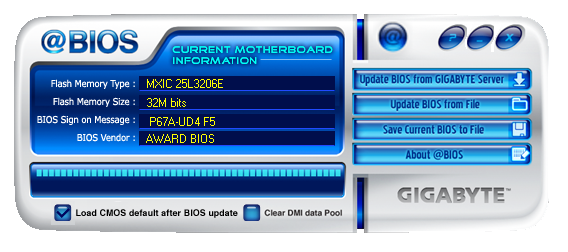
@BIOS is the staple Gigabyte BIOS update utility, and has been for a few iterations now. Users should note that to flash the latest BIOS files, the version of @BIOS on the CD is insufficient, and @BIOS 2.1 is required. 2.1 can be downloaded from the Gigabyte website.
Dynamic Energy Saver 2
Another program that Gigabyte has been using on various chipsets is the Dynamic Energy Saver 2. As you can see from the picture, various power saving features can be enabled or disabled through user settings, or you can let the software determine the best course of action.
EasyTune6
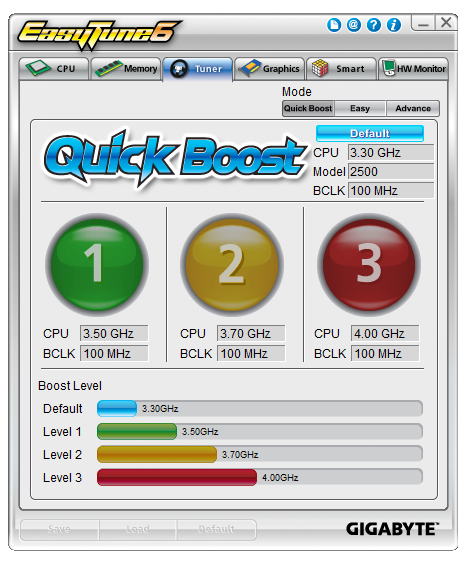
The OS overclocking tools are predominantly housed in EasyTune6. The front screen has those easy to use OC buttons, but only having three up to 4 GHz is somewhat limiting on the Sandy Bridge platform, given that most processors will happily do 4.4 GHz plus. There is no system of auto-overclocking detection similar to the ASUS boards.

Despite the software having an option for ‘real time ratio change’, of which there is an option in the BIOS to enable/disable, I could not get this to work. Upon setting a new multiplier, I was asked to reboot to apply it.
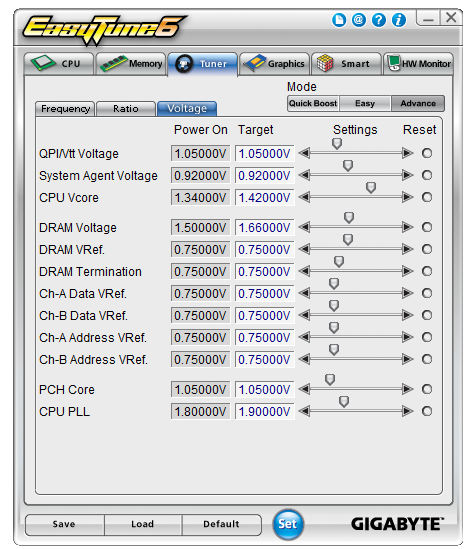
As always with EasyTune6, going to advance mode allows voltage manipulation. While it is nice to have such a wide variety of options, given that for Sandy Bridge all you really need is CPU VCore, DRAM and CPU PLL, it would have been easy just to include those in the ‘easy’ mode.

Fan control is basic in EasyTune6. Even in advanced mode, as shown above, you can choose where to put the initial and final ramp positions in terms of temperature against max RPM, but there is no option to define further points on the curve, or no determination of separate fans, so all chassis fans will be controlled by this one profile.



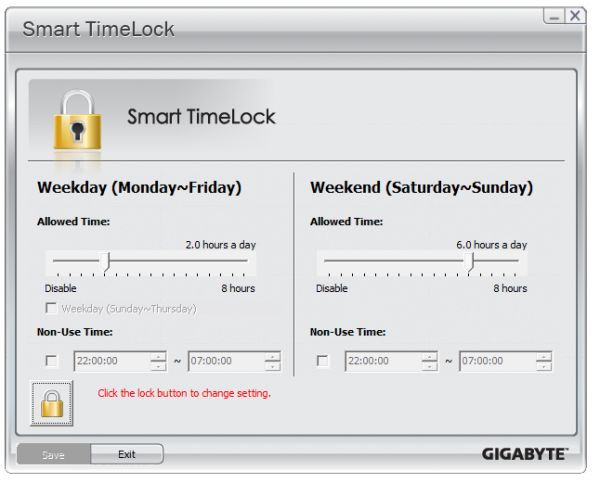
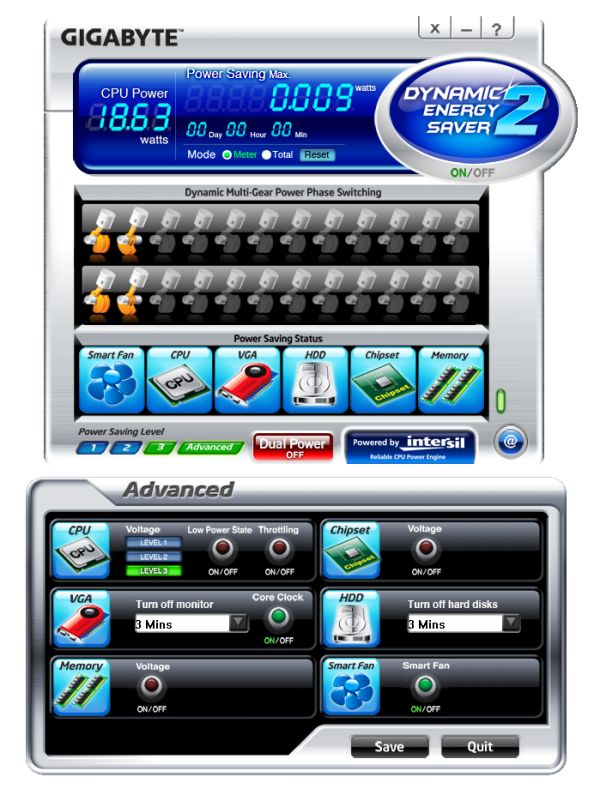








137 Comments
View All Comments
GeorgeH - Thursday, January 20, 2011 - link
On the temperature and power graphs, you might want to differentiate the colors a bit more. Right now it looks like OCCT/Idle are using the exact same shade of purple, and Metro/Video are using the exact same shade of red. Common sense tells me which is which, but it just looks bad.Overall it was a great review; the only thing I'd change would be to put Gigabyte's "BIOS Classic" implementation into the pros column, but I'm weird like that.
Peanutsrevenge - Thursday, January 20, 2011 - link
I have the HTC Hero aswell running Cyanogenmod ROM for 2.2 and the BT Turbo Remote software is showing in my market (version 1.0.9) if you wanna recheck it Ian and update the article.Interesting that you had such trouble with the Gigabyte board, I went off Asus a few years ago due to several glitches, bugs and DOAs and switched to speccing / recommending Gigabyte for friends and customers.
Hope this is a one off for them rather than the end of a faultless era!
sweetspot - Thursday, January 20, 2011 - link
Why do MOBO test sites all fail to add sound quality test to the benchmarks ?? Most folks spending over 150.00 for a mobo and playing games and entertainment, would like nice quality sound as well.Cant spend 190 bucks without asking the sound question, nobody would by a board without the over all picture, not just A wins B in a frames bench test.
Is sound onboard good or not ? do we lose xfire / SLI if we go with add on sound card option . Nobody would buy a mobo without asking that simple question as well, and why does every single review site 99% of the time skip a simple sound quality mention on boards they test ??
No mention of sound quality in a mobo review is just pitifull, cant be that hard to tell someone if it even works or not, alot of boards onboard sound is broken on release, all the review sites always fail to skip that test, so it never gets seen when they give nice review so people go out and buy busted parts.
A simple basic sound paragraph mention as to yes sound in games / videos / chatting were clean and x # of channels responded correctly. Or sound worked but the mic and mic boost options were broken, so dont buy if you online chat which alot of poeple do? How do you skip such a important detail ??
All this was, is a comparison of 190 bucks worth or silence!!
kepstin - Friday, January 21, 2011 - link
If you really care about sound quality, you're probably going to end up using a digital audio output; either co-ax/optical on the motherboard, or via HDMI. At that point it doesn't matter which sound card you have, because you're not using the onboard DAC at all.Rick83 - Friday, January 21, 2011 - link
The quality of the clock generator still matters, though.sweetspot - Friday, January 21, 2011 - link
Not true as the question poised clearly states,Most would think a mobo review would include some sort of sound testing as well as just frames, But no sound quality test or mentions in review of 2 different boards comparison, So review of which is faster but no other quality reasons of the boards are compared aka sound ?? why ??
The cost of extra sound card makes huge difference in product purchases, and not reviewing the key pieces is not helpfull at all in my opinion.
Most readers rely on review sites as they have access to parts a normal user does not get alot of computer parts every day to test with.
This review is a A is faster then B review vs a review like A is better quality / price over all then B review which it seems was intended to be ??
strikeback03 - Friday, January 21, 2011 - link
Both are using the Realtek ALC892, so theoretically should be very similar. I'd agree a "it works" should probably be mentioned, but other than that substantial sound quality testing can be extremely subjective.Hrel - Thursday, January 20, 2011 - link
Are there reviews of the new 15.6" notebooks based on Sandy Bridge with the GT540M and GTX460M coming? You know the ones, from Clevo and Compal with 1080p screens? I've seen them at a couple different places including a very good deal on the GTX460 Clevo from Cyberpower.com. Please please please at least let me know if these reviews are in the pipeline or not.Hrel - Thursday, January 20, 2011 - link
So why is it that as more and more of the load gets put on the CPU, the northbridge, memory controller, GPU, these motherboards are getting more expensive? Seriously? It doesn't make any sense.Is this why Intel is SOOO far behind supporting USB 3.0 and more than 2 measly SATA 6GBPS ports? LGA 775 I had no issue at all getting a very nice board that OC's well and is still running perfectly and while originally supported P4 was updated in the BIOS to support the latest quad core Penryn's on 45nm and it STILL runs like a dream. LGA 1156 I had to just up to the 100-130 range and depending on who I was building for would go up nearing 150.
But now simple things like SLI require a 200 dollar boards? I know that wasn't supported on the other old boards but it's called "progress" for a reason. I consider that a standard feature now not something reserved for rich people. It is unacceptable to pay more than 150 for a motherboard, even if you put bluetooth on it call it the "Royal Excaliber 12000" and have a prince sign it. Seriously, I didn't expect to see prices over 200 at all till X68 came out. WTF guys, WTF!
MeanBruce - Thursday, January 20, 2011 - link
Royal what? I used to have a patient named Royal Ruffles, his real name, so peculiar I thought, oh yeah back to mobos. So interesting some readers think it's stupid to spend $200 for a new mainboard while others have no problem dishing out $430 or $450. I mean we are enthusiasts right? It's tax deductible, so I am all for drooling over new Z-branded chipsets and LightPeak support and 16GB of quad memory and incorporated northbridge and overclocking it all with your iPhone. It's a hobby right? It's supposed to be a blast!